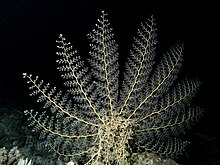

| Basketstars | |
|---|---|

| |
| Astroboa nuda basket star feeding at night in the Red Sea | |
| Scientific classification | |
| Domain: | Eukaryota |
| Kingdom: | Animalia |
| Phylum: | Echinodermata |
| Class: | Ophiuroidea |
| Order: | Phrynophiurida |
| Suborder: | Euryalina Lamarck, 1816 |
| Families | |
|
Asteronychidae | |
The Euryalina are a suborder of brittle stars,[1] which includes large species with either branching arms (called "basket stars") or long and curling arms (called "snake stars"). It is sometimes listed as the order Euryalida.[2]
Many of the species in this order have characteristic repeatedly branched arms (a shape known as "basket stars", which includes most Gorgonocephalidae and two species in the family Euryalidae), while the other species have very long and curling arms, and go rather by the name of "snake stars" (mostly abyssal species). Many of them live in deep sea habitats or cold waters, though some basket stars can be seen at night in shallow tropical reefs. Most young basket stars live on specific type of coral.[3] In the wild they may live up to 35 years. They weigh up to 5 kilograms (11 lb). Like other echinoderms, basket stars lack blood and achieve gas exchange via their water vascular system.
The basket stars are the largest ophiuroids with Gorgonocephalus stimpsoni measuring up to 70 cm in arm length with a disk diameter of 14 cm.[4]
The fossil record of this group is rather poor and only dates back to Carboniferous.[5] Basket stars are divided into the following families:
| Euryalina |
|
|---|---|
| Euryalida |
|
This Ophiuroidea-related article is a stub. You can help Wikipedia by expanding it. |